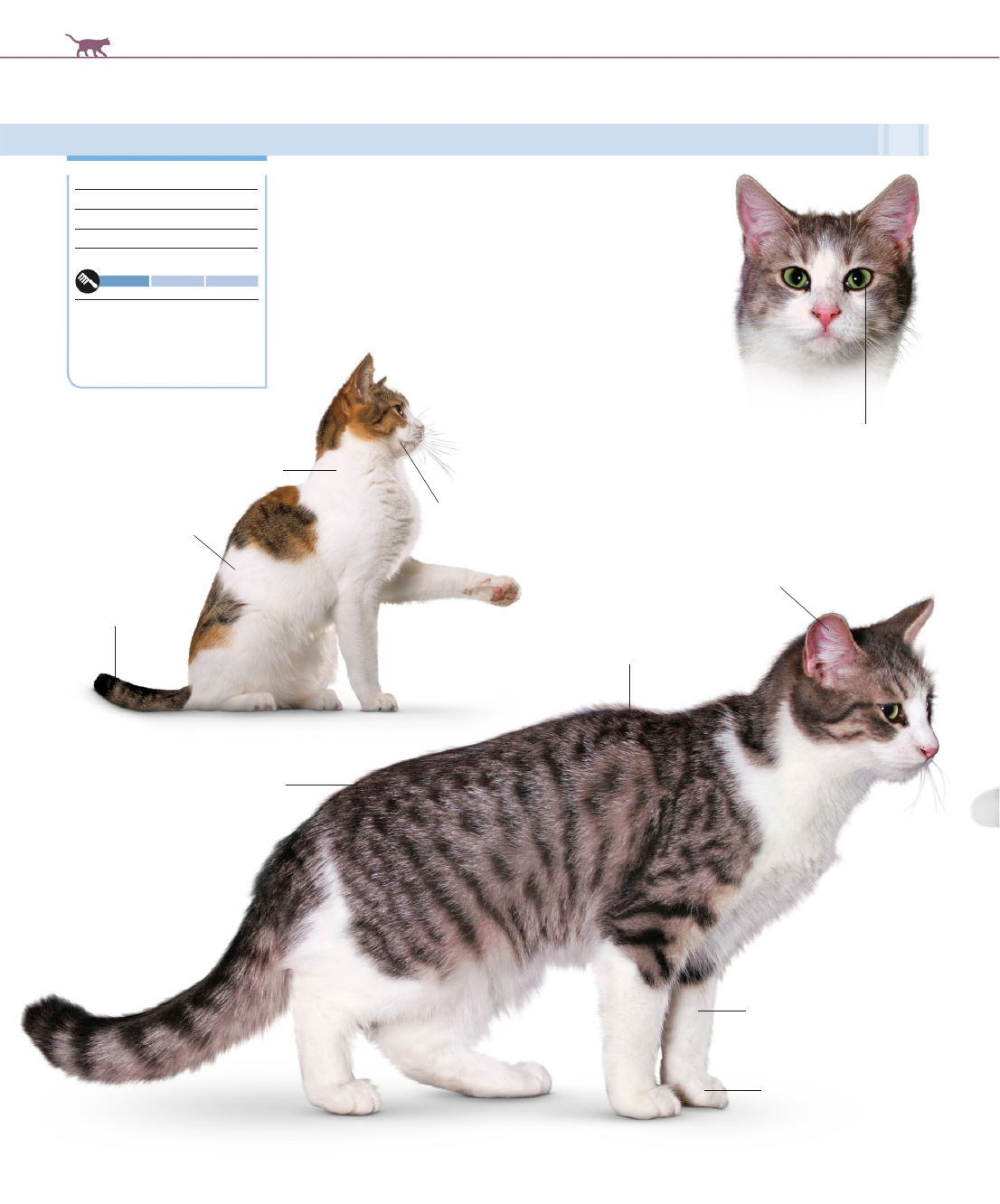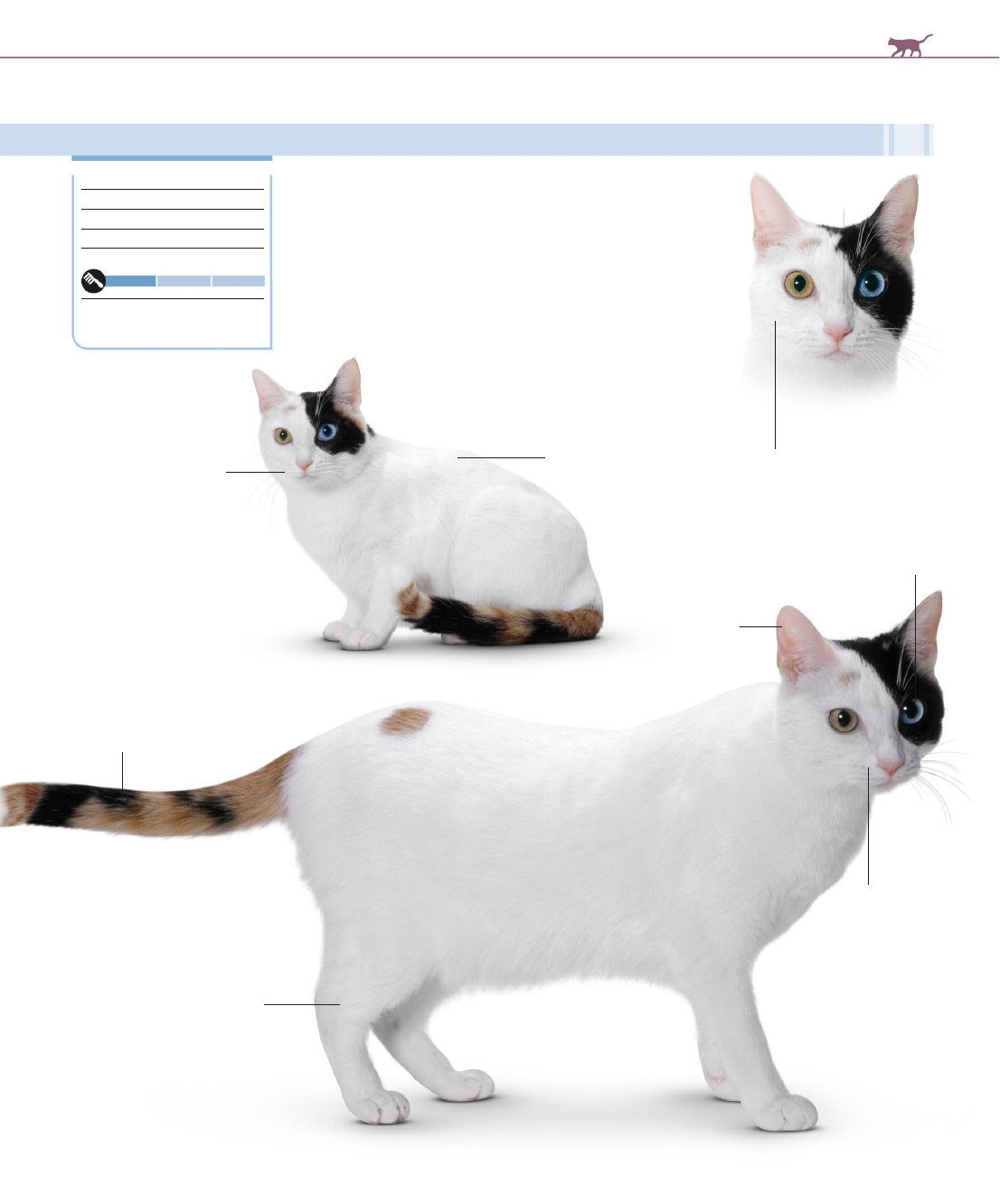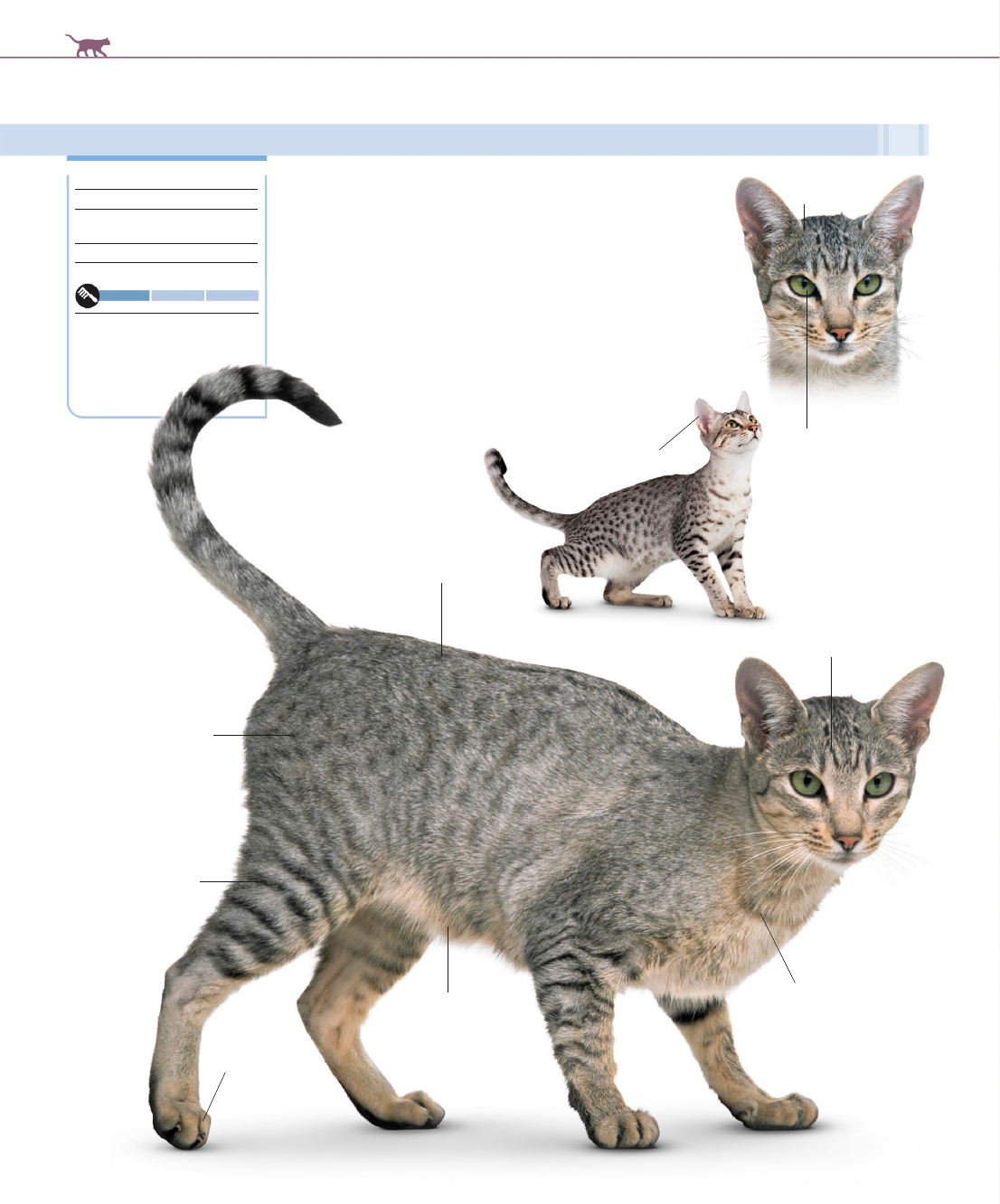
77
SHORTHAIRS
MINGLED COLORS GIVE THIS CAT’S COAT AN UNUSUAL MARBLED APPEARANCE
BRITISH SHORTHAIR—TORTIE
In a tortoiseshell (tortie), two coat colors are softly
blended. There are many variations, but the most common
is black mixed with red—the first tortie color to be developed
in British Shorthairs. Blue-cream tortoiseshell, in which black
is replaced by blue and red by cream, is another of the
older colors, recognized since the 1950s. In the Calico
(known as Tortie and White in the UK), the colors are
more clearly defined as patches. For genetic reasons,
torties are nearly always female
and the few males are sterile.
Place of origin UK
Date of origin 1800s
Breed registries CFA, FIFe,
GCCF, TICA
Weight range 9–18 lb (4–8 kg)
Grooming
Colors and patterns
Blue-cream, chocolate, lilac,
or black tortoiseshell (with
white patches in the calico).
White markings
cover a third
of the body
Ears broad
at base
Slight dip
in nose
Short, level backDense
tortie coat
Red and black
color areas
intermingle evenly
White paws
Deep orange
eyes
Broad
chest
Rounded paws
Areas of tortie
patterning
clearly defined
US_076-077_Brtsh_SH-Gldn-Brtsh_SH_trte-White.indd 77US_076-077_Brtsh_SH-Gldn-Brtsh_SH_trte-White.indd 77 11/02/21 7:04 PM11/02/21 7:04 PM

CATALOG OF BREEDS
78
A LITTLE-KNOWN BREED THAT IS AFFECTIONATE AND EASYGOING WITH PEOPLE
TURKISH SHORTHAIR
The history of the Turkish Shorthair is uncertain, but this
cat occurs naturally in various regions of Turkey and has
probably existed there for a considerable time. Also known
as the Anatolian or Anatoli, and the Anadolu Kedisi in
Turkey, the breed is similar to the longer-haired Turkish
Van cat (p.176). The Turkish Shorthair is rare even in its
native country, but breeders, particularly in Germany
and the Netherlands, are working to increase its numbers.
This strong, agile cat has a great liking for
playing in or with water and is known
to enjoy a bath.
Strong,
muscular legs
Powerful,
medium-sized body
Large, slightly
almond-shaped eyes
Tail
slightly
rounded
at tip
Neat, round paws
Moderately broad head
with rounded jaw
Ears wide
at base and
set well apart
Place of origin Turkey
Date of origin pre-1700s
Breed registries Other
Weight range 7–19lb (3–8.5kg)
Grooming
Colors and patterns
All colors except chocolate,
cinnamon, lilac, and fawn, and
all patterns except pointed.
Short, dense
tabby and white coat
with no undercoat
Muscular
neck
Tortoiseshell and
white coat
US_078-079_Anatolian_Ojos-Azules.indd 78US_078-079_Anatolian_Ojos-Azules.indd 78 11/02/21 7:04 PM11/02/21 7:04 PM

79
SHORTHAIRS
THIS RARE AND ENIGMATIC BREED IS A NEWCOMER ON THE PEDIGREE CAT SCENE
OJOS AZULES
First discovered in New Mexico in 1984, the Ojos Azules
(the name means blue eyes in Spanish) is one of the rarest
cats in the world. The stunning eye color is particularly
unusual in that it appears with any coat color or pattern,
in one or both eyes, including in the longhaired version.
Development of the breed has been slow due to health
problems that seem to occur when the gene for blue
eyes is inherited from both parents. Hence the outcross
to other non blue-eyed cats. A pretty and
graceful cat, the Ojos Azules is said to be
affectionate and friendly.
Sweet
expression
Square
muzzle
Fine, silky white coat with
black and red tortie markings
Ears set
relatively
high on head
Triangular head
with prominent
cheekbones
Nose has
slight
stop
Hindlegs
slightly longer
than forelegs
Place of origin US
Date of origin 1980s
Breed registries TICA
Weight range 9–12lb (4–5.5kg)
Grooming
Colors and patterns
All colors and patterns.
Different
colored eyes
Tapering tail with
extensive tortie
markings
US_078-079_Anatolian_Ojos-Azules.indd 79US_078-079_Anatolian_Ojos-Azules.indd 79 11/02/21 7:04 PM11/02/21 7:04 PM

CATALOG OF BREEDS
80
STRIKINGLY PATTERNED, THIS IS THE ONLY NATURALLY SPOTTED DOMESTIC BREED
EGYPTIAN MAU
This cat bears a certain resemblance to the long-bodied,
spotted cats seen in the tomb paintings of Ancient Egyptian
pharaohs, but it cannot claim direct descent. The modern
Egyptian Mau was developed by Natalie Troubetzkoy, a Russian
princess in exile, who in 1956 imported several spotted Egyptian
cats to the US from Italy. Here, the number of breeding cats
remained small for many years until new imports late in the
20th century reinvigorated the gene pool. Maus are affectionate
cats but are also inclined to be sensitive and shy. They need
thoughtful socializing at an early age and are probably
best suited to an experienced cat owner.
However, once a Mau bonds with its family,
it stays devoted for life.
Forehead has
typical tabby
“M” marking
Spots on coat
are random
Large,
almond-shaped
green eyes
Broken necklace
patterns on upper
chest and neck
Small, slightly
oval feet
Hindlegs longer
than forelegs
Medium-long,
wedge-shaped
head
Place of origin Egypt
Date of origin 1950s
Breed registries CFA, FIFe,
GCCF, TICA
Weight range 6–11 lb (2.5–5 kg)
Grooming
Colors and patterns
Bronze and silver in spotted
tabby pattern. Black
smoke has ghost
tabby markings.
Loose flap of
skin between
flank and
hindleg
Bronze spotted
tabby coat
Broad-based,
fairly large ears
US_080-081_EgyptianMau_SPS.indd 80US_080-081_EgyptianMau_SPS.indd 80 11/02/21 7:04 PM11/02/21 7:04 PM

RARE BEAUTY
A silver Egyptian Mau stalks through
long grass, huge green eyes fixed on
a possible target. This stunning spotted
cat, which comes in three recognized
colors, is extremely rare.
US_080-081_EgyptianMau_SPS.indd 81US_080-081_EgyptianMau_SPS.indd 81 11/02/21 7:04 PM11/02/21 7:04 PM
..................Content has been hidden....................
You can't read the all page of ebook, please click here login for view all page.
